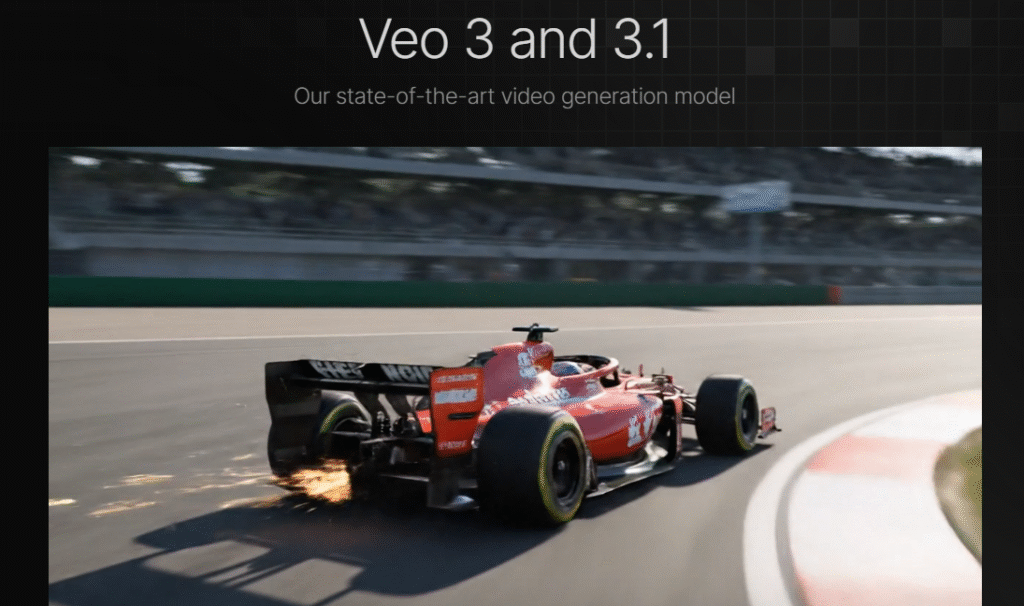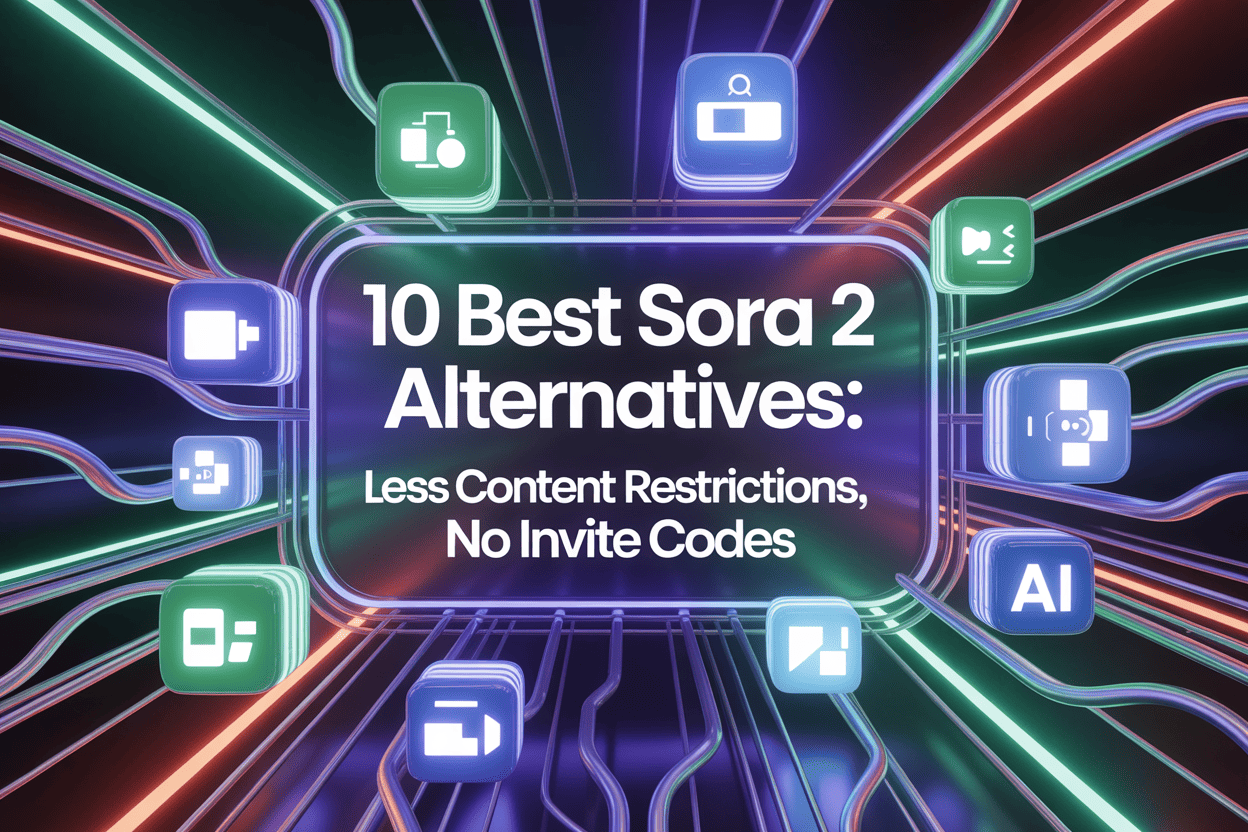Sora 2 alternatives are essential for creators seeking flexibility and freedom. Although OpenAI’s Sora 2 amazed the world with cinematic AI videos, its strict content filters, invite-only access, and watermarking make it difficult for most creators to use. Fortunately, there are other platforms that allow you to generate high-quality videos without these limitations.
In my testing of 10 AI video platforms in 2025, Global GPT emerged as the best alternative, seamlessly integrating Sora 2 and over a dozen other video generation models. It delivers an experience that surpasses the original Sora 2—no invite codes required, fewer restrictions, and completely watermark-free.
Global GPT currently integrates Sora 2 Pro, which can generate videos up to 25 seconds long. Normally, Sora 2 Pro is only available for users with a $200/month ChatGPT Pro subscription, but with Global GPT, you can use it without the expensive subscription.

What Are AI Video Generators?
AI video generators are powerful tools that transform text prompts, images, or audio into dynamic video content using artificial intelligence. Essentially, you provide a description—like “a golden retriever puppy playing in a field of flowers”—and the AI produces a realistic or stylized video that matches your prompt. Some generators can even animate still images or replicate human voices for narration.
How I Selected the Best Sora 2 Alternatives
To identify the most suitable alternatives to Sora 2, I focused on what truly matters to content creators. My evaluation boiled down to a few straightforward questions:
- Is it actually usable? I prioritized platforms that offer simple sign-up processes and stable performance. Many websites suffer from technical issues and API limitations, leading to unreliable products.
- Does it generate high-quality videos? I assessed whether these alternatives can match the video generation quality demonstrated by Sora 2.
- What is the pricing structure? I considered whether the pricing is transparent and reasonable.
- Does it offer a variety of video generation options? I looked for platforms that support multiple video generation models, allowing users to choose the best fit for their needs.
1 Global GPT – Powered by Sora 2, Yet Beyond Its Limits
The reason I put Global GPT first is that it’s the perfect alternative to Sora 2, offering an even better and more seamless experience as an integrated platform for it.
It integrates more than a dozen video-generation models, including Sora 2 and Veo 3.1, giving you the ability to combine the strengths of multiple AI models in one workflow.
There’s no invite required, no watermarks, and a smooth, user-friendly interface that makes professional video creation accessible to everyone.
Why Global GPT stands out:
- No invite codes – Start immediately.
- No watermarks – Clean, professional output.
- Multiple models integrated – Sora 2, Veo 3.1, and 10+ other video-generation engines.
- Cross-model flexibility – You can experiment and combine different model strengths for cinematic, stylized, or 3D content.
During testing, I generated a 30-second cinematic clip using both Sora 2 and Veo 3.1 within the platform. By blending the models, I achieved richer motion dynamics and more nuanced lighting than using a single AI tool. For creators producing marketing videos, social clips, or short films, this flexibility is a game-changer.
Pricing:
- Free access (limited for trial)
- Basic Plan: $5.8/month
- Pro Plan: $10.8/month with 46% Flash Sale discount
- Unlimited Plan: $25.0/month with 50% OFF
subscription plans vary for extended usage.
Pros: All-in-one, model diversity, professional output.
Cons: Advanced features can be overwhelming for complete beginners.
2 Veo 3.1 – Google’s Next-Gen AI Video Model

Veo 3.1 ranks second because, when it launched last week, it was widely recognized as the strongest challenger to Sora 2.
Veo 3.1 stands out as one of the most advanced AI video generation tools available today. While working on a short promotional clip, I tried its new First and Last Frame feature—where you can upload a starting and ending image—and was impressed by how seamlessly it transitioned between them. The resulting clip maintained consistent character appearance, lighting, and ambient sound throughout.
Key Highlights:
- Native audio generation: Veo 3.1 automatically produces ambient noise, dialogue, and sound effects that match the generated scene.
- Prompt fidelity & visual consistency: I uploaded two reference images of my character and, using the clip extension tool, generated a ~15-second sequence that stayed visually consistent.
- Scene extension: I extended a 10-second clip into roughly 35 seconds using Veo 3.1’s scene-extension feature. The continuity remained stable, though the extended portion plays at 720 p resolution.
Pricing: Currently available in paid preview via the Gemini API, with public pricing details yet to be released.
Pros: Realistic visuals, synchronized sound, and strong prompt control.
Cons: Some features are still in preview and require tuning for best results.
Overall, Veo 3.1 is a compelling choice for creators and studios seeking cinematic-quality AI video generation with broader accessibility—making it a true rival to Sora 2 in 2025.
3 Synthesia – Create AI Videos with Your Own Avatar

Synthesia ranks third because it offers a small feature similar to Sora 2’s Cameos.
Synthesia stands out for how effortlessly it lets you create realistic AI videos featuring your own digital avatar. I tested the tool by uploading five selfies and a short 30-second voice clip, and within under three minutes, I had a video of myself delivering a message as if I were standing in a cozy café. The facial expressions and lip-sync were surprisingly accurate — even subtle head tilts and smiles were captured naturally.
The platform’s Express-2 avatars make it even faster to get started. You simply click “Get started for free”, and Synthesia generates a ready-to-use AI presenter in seconds, without needing any editing skills. These avatars can be used for social media videos, business presentations, or even video calls, giving creators and professionals a flexible, camera-free production option.
Like Sora 2’s Cameos feature, Synthesia requires users to give consent for their image and voice usage, ensuring privacy and ethical use of likenesses.
Key Features: Custom selfie avatars, lifelike motion capture, 120+ languages, fast rendering.
Pros: Quick setup, natural facial animation, ideal for personal or professional use.
Cons: Avatar customization requires clear selfies; limited creative scene flexibility.
4 Runway – Best for Realistic, Cinematic Video
Runway continues to be my top pick for professional-level AI video creation. In my testing, I generated a 20-second action scene using the Gen-4 model, and the result was impressively smooth and cinematic, with realistic motion and lighting. I also experimented with object removal and motion tracking tools—these features worked seamlessly, letting me refine scenes without needing additional software.
Key Features: Full creative suite, motion tracking, object removal, Gen-4 model quality, advanced scene control.
Pricing:
- Free: One-time 125 credits (about 25 seconds of video)
- Standard: $15/user/month for 625 monthly credits
- Pro: $35/user/month for 2,250 monthly credits
- Unlimited: $95/user/month for 2,250 credits plus unlimited relaxed-speed generations
- Enterprise: Custom pricing for large teams
Pros: High-quality, cinematic output; professional-grade editing tools; reliable performance for longer sequences.
Cons: Steeper learning curve for beginners; credit-based system can make cost planning a bit tricky.
In my experience, Runway is ideal if you want full control over video composition and need a tool that can handle complex, cinematic projects without compromise. The combination of Gen-4 quality and over 30 editing tools makes it one of the most versatile Sora 2 alternatives available today.
5 Kling AI – High-Fidelity, Fast Generation
Kling AI is a fast-rising tool from the team behind TikTok, designed for creators who need realistic motion in longer clips. I tested a 2-minute 1080p video, and the AI handled character movement and physics with impressive naturalness, making the final output feel smooth and professional. It’s ideal for marketing videos, short films, or any project where lifelike motion matters.
Key Feature: Supports long clips up to 2 minutes, realistic motion and physics.
Pricing: Currently free during the launch phase.
Pros: High-fidelity video, rapid generation, natural movement.
Cons: Feature set is still expanding, and availability may vary by region.
6 HeyGen – AI Avatars & Corporate Presentations
HeyGen focuses on creating videos with AI avatars, making it ideal for corporate training, explainer content, or sales presentations. In my experience, I cloned my own voice and produced a polished corporate presentation in under 10 minutes, with realistic avatar movements and clear lip-syncing. The platform supports over 1,000 avatars and videos in more than 175 languages, which is perfect for global teams or multilingual content.
Key Features: AI avatars, voice cloning, pre-made templates.
Pricing: Free plan (3 videos/month); Creator $29/month; Team $39/seat/month; Enterprise custom pricing.
Pros: Professional results, multi-language support, quick production.
Cons: Free plan is limited, not designed for open-ended creative video projects.
7 Pika – Best for Stylized Animation
Pika shines for creators who want animated or stylized videos without the complexity of professional editing. I experimented with a 4-second music clip, using its automatic lip-sync and sound effect generation, and found the characters’ expressions and timing surprisingly accurate and engaging. This makes it perfect for social media content, short stories, or fun promotional clips.
Key Features: Automatic lip-sync, sound effects, stylized character animation.
Pricing: Basic Free Plan (250 credits); Standard $10/month; Unlimited $35/month; Pro $70/month.
Pros: Extremely beginner-friendly, quick setup, fun and expressive results.
Cons: Clips are short, and photorealistic quality isn’t as consistent as more advanced tools like Runway.
8.Luma AI – 3D & Immersive Content
Luma AI excels at generating high-quality, imaginative 3D and immersive videos. I experimented with a text-to-video prompt to create a 3D landscape, and the results were visually stunning with smooth motion and clear depth. The platform also supports NeRF 3D capture, making it ideal for creators exploring immersive scenes. However, I found the lack of transparent pricing and the branding confusion with Luma Labs a bit frustrating.
Key Features: NeRF 3D capture, immersive 3D video generation.
Pricing: Custom (not publicly available).
Pros: High creative flexibility, excellent 3D content.
Cons: Pricing not transparent, minor branding confusion.
9. InVideo AI – Marketing & Social Media Content
InVideo AI is tailored for marketers and social media creators who need to produce content quickly. I tested it by creating a 1-minute promotional video, and the platform generated a complete package—including script, relevant stock footage, automated voiceover, and editing—within minutes. The workflow is intuitive, and the massive library of over 6,000 templates makes it easy to adapt for different campaigns.
Key Features: 6,000+ templates, full automation from prompt to video.
Pricing: Free (10 minutes/week); Plus $28/month; Max $50/month.
Pros: Extremely time-efficient, beginner-friendly, minimal manual effort.
Cons: Depends on stock footage, does not generate entirely new scenes like Sora 2.
Cons: Relies on stock footage, not fully original scene generation.
10 Pictory AI – Turn Text Into Video
Pictory AI is one of my go-to tools when I need to turn long-form written content into bite-sized videos for social media. I once used it to convert a 1,500-word blog post into a 3-minute video — complete with captions, AI voiceover, and relevant stock footage — all in under 10 minutes. The platform’s AI automatically summarizes your text, selects matching visuals, and syncs everything smoothly, making it perfect for repurposing blogs, scripts, or articles into social-ready videos.
While it’s incredibly beginner-friendly (you really don’t need any video editing skills), the AI-generated voices on the Starter plan can sound slightly robotic. Also, since it relies on stock footage rather than generating custom scenes, it’s best suited for marketing teams, creators, or educators who prioritize speed over originality.
Key Features: Automated text-to-video creation, AI summarization, captions and voiceover generation.
Pricing: Starter $25/month (200 video minutes/month); Professional $49/month (600 video minutes/month); Teams $119/month (1800 video minutes/month).
Pros: Extremely easy to use, efficient for content repurposing, fast turnaround.
Cons: AI voices sound less natural on lower-tier plans, limited to stock visuals.
Final Thoughts: Why Global GPT Leads
Global GPT combines accessibility, flexibility, and professional-grade video output in one platform. By integrating Sora 2, Veo 3.1, and other models, it lets creators experiment, combine, and optimize outputs like no other platform. For marketers, social creators, and filmmakers in 2025, Global GPT represents the most practical and powerful Sora 2 alternative.
FAQ
Q1: Are there free Sora 2 alternatives?
A1: Yes – Global GPT (trial), Kling AI, Pika (basic) all provide free access.
Q2: Can these tools be used for professional marketing videos?
A2: Absolutely. Tools like Global GPT, InVideo AI, and HeyGen produce polished, client-ready videos.
Q3: How do alternatives compare to Sora 2 in quality?
A3: Global GPT and Veo 3.1 approach Sora 2-level realism, while Pika or Luma AI excel in stylized creativity.
Q4: Are these beginner-friendly?
A4: Most offer templates, AI guidance, and intuitive interfaces suitable for novices.



